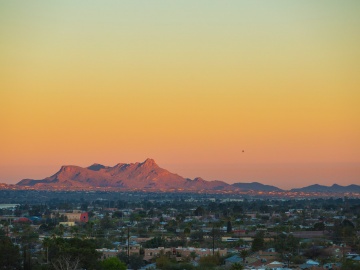
A new interdisciplinary research project seeks to harness digital visualization to increase public education and involvement in policy decisions, as the Tucson area considers ways to adapt to extreme heat brought on by climate change and the urban heat island effect.
With a grant of $8,850 from the Office for Research, Innovation and Impact, “Visioning a Cooler Tucson: Participatory Planning for Extreme Heat Resilience” will study ways to increase the level of public input and support that can lead to more effective heat mitigation strategies.
Part of the “Grand Challenges” pillar of the University of Arizona’s strategic plan, the pilot project brings together Jonathan Jae-an Crisman, Assistant Professor of Public and Applied Humanities; Ladd Keith, Assistant Professor of Planning and Sustainable Built Environments; and Gregg Garfin, Associate Professor in the School of Natural Resources and the Environment.
“Interdisciplinary collaboration is a key piece of what Public and Applied Humanities is all about,” Crisman says. “Ladd and Gregg are experts about these extreme heat adaptation strategies. The expertise I’m providing is on the connection between culture, decision making, and strategies for visualization.”
Current research shows a number of climate change adaptation strategies for extreme heat in a desert landscape like Tucson’s, ranging from increasing shade through strategic tree planting, installation of shade structures, and providing amenities like splash pads. Some of these adaptation strategies have trade-offs like increased water use or landscape maintenance costs. The implementation of any adaptation strategy can be improved through a process that includes public education and participation, Crisman says.
“Tucson will be severely impacted. The reality is we’re going to have to use some of these strategies, whether we like it or not,” he says. “My question is what is the role of culture and preference in selecting these, and how can you create a participatory process that will educate and inform people about the options and get feedback from the public about how we make decisions?”
The project includes the creation of an interactive visual learning tool that helps people understand the implications of climate change, the urban heat island effect, and extreme heat, and make informed decisions about their own preferences for strategies to reduce impacts. The digital tool will include information about extreme heat and the impacts of a variety of planning and design adaptation strategies. After participants have examined material in the learning modules, a poll will collect their feedback about desired interventions and data about the impact of the learning process.
“We’re going to collect all that information and share it with policy makers and experts, to inform the about public preferences. Often these decisions are made from the top down by policy makers without a robust participatory process,” Crisman says. “But one common finding in participation studies is the fact that people don’t like policies and regulations when they’re imposed upon them. If you give people a stake in the decision-making process, they’re often willing to select options that otherwise they wouldn’t accept if enacted without their input.”
The interactive visual learning tool will be developed in time for testing in July, with two groups of participants who will take a pre-survey, use the tool and go through the online learning modules, and conclude with the post-survey. The groups are the 2020 cohort of Recharge the Rain, K-12 teachers developing climate literacy curricula, and participants through the UArizona Extreme Heat Network community of research and practice. Using interactive graphics, as a way to teach the public, can create connections between the lay public, activists and expert groups like scientists and policy makers.
“We’re hoping this tool is a meeting point for all those different groups. By a more nuanced understanding of culture and preference, there might be the political will to implement some adaptive strategies that might seem drastic,” Crisman says. “The other exciting thing we are hoping for is a second phase where this tool will be refined and made more universally usable, so other areas facing extreme heat can implement similar participatory processes in their own communities.”

